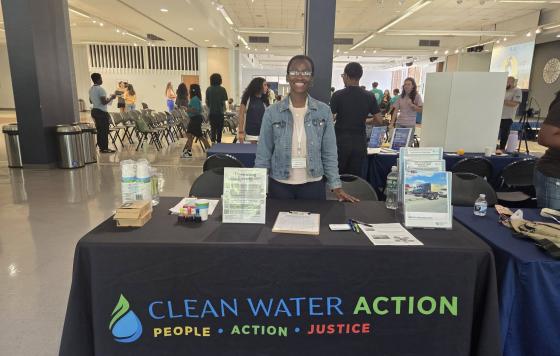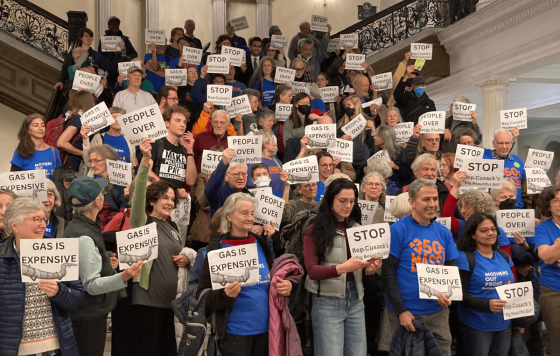
Clean Water Action is one of 180 housing, community, and climate organizations asking the Massachusetts Legislature to create a Zero Carbon Renovation Fund - $300 million to support “deep energy retrofits” of housing, schools, and institutional buildings. Deep energy retrofits involve making the exterior of a building as air-tight and well insulated as possible to reduce the energy needs of the building and then connecting the building to heat pumps, modern electric appliances, and electric water heaters powered by clean energy. These retrofits add up to huge savings on energy costs for communities and residents and are a long term investment in our climate future! The Zero Carbon Renovation Fund is the down payment we need now on the future we want to see.
One of our allies leading this effort is Mary Wambui, an Asset Manager at the Planning Office of Urban Affairs. Ms. Wambui is also an appointee to the Massachusetts Energy Efficiency Advisory Council (EEAC) and Co-chair of the EEAC's Equity Working Group. Earlier this spring, Clean Water Action sat down with her to discuss how the Zero Carbon Renovation Fund will work and why it is so necessary for both climate justice and economic justice.
Why do we need a zero-carbon renovation fund?
To get to our climate goals in Massachusetts, we have to do something radical about reducing carbon emissions affordably and for all in existing buildings. Retrofits require sizable upfront capital expenditures, and that is why Massachusetts needs a Zero Carbon Renovation Fund (ZCRF).
What would this bill do that is not already being done by Mass Save?
One of the cross-cutting recommendations from the Clean Heat Commission (a Massachusetts body tasked with reducing greenhouse gas emissions from heating and cooling buildings) is that the transition must be resourced, and that Mass Save will not be sufficient. The Clean Heat Commission identifies a need to significantly increase funding for early investments in innovation, market development, and more. Therefore, it’s not so much about what Mass Save is not doing; the reality is that the transition needs additional resources like the ZCRF.
The ZCRF will offer flexibility from conventional Mass Save-regulated cost effectiveness metrics. It will allow for investment in cutting edge projects that will transform the market and reduce greenhouse gasses and costs in the long term. It will provide a whole building approach which does not happen with Mass Save. (A whole building approach is a comprehensive design approach to efficiency. It requires designers and installers to consider the way the building enclosure, orientation, glazing, materials, ventilation, insulation, moisture management, and air flow all work together with appliances, heating and cooling systems.)
You work in affordable housing. Is there specific work that you or your organization could do if this funding was available?
We have a couple of existing rehabilitation projects . One is a 6 building project with buildings that are between 2-7 stories in height and contain 179 units. Heating fuel is gas and domestic hot water is gas. This 179-unit building will be over its emission limit in 2030.
As it is, even without considering updated energy codes and climate mandates, this project, like other affordable housing projects, has backlogs of deferred maintenance and therefore traditional affordable housing sources will not be sufficient to fund climate mandates. The ZCRF will be targeting deep energy retrofits by funding the capital gap which will make measures such as balanced mechanical ventilation, high-performance building envelopes, air sealing, and continuous insulation a reality in the project.
Why are these types of “zero carbon” renovations so important?
In affordable housing, renovations that reduce energy consumption have the potential to reduce energy burdens which are very high among low and moderate income people in a city like Boston where the project is located. They boost operational efficiency and promote better indoor air quality and comfort. BIPOC communities have a high asthma burden, and healthier housing can be a step towards addressing this disparity. These renovations also integrate resiliency. We have a project in Scituate that sometimes loses power for 5 days which is a huge risk for residents on oxygen. Solar and storage can address resiliency if incorporated in a zero-carbon renovation scope.
There was an article in the Boston Globe about climate planning being a possible way to address historic racial inequities in Boston. How could this bill to address climate change help to address some of the specific social, economic, and environmental harms directed towards African American and Latinx Bostonians?
This bill will provide equitable climate action opportunities like:
- Access to benefits such as reduced energy burdens.
- Investments in resiliency features like solar and energy storage in housing and infrastructure upgrades through municipalities.
- School upgrades that will address the underinvestment that has plagued BIPOC communities through structural racism and neglect.
- Avoidance of burdens like asthma due to poor housing.
Creation of jobs in communities that have been left out of the climate action benefits world for years and creation of opportunities for minority owned businesses, women owned businesses, and disadvantaged businesses to participate through access to contracts. The list goes on and on.
There are lots of important bills pending before the Legislature. Why have you chosen to focus your legislative advocacy efforts on this one?
Because electrification and efficiency in existing buildings presents a larger challenge than new construction, as this stock represents the bulk of emissions reductions needed by 2050. We have at least 2 million old buildings with high emissions that no amount of new construction will shave off. This is urgent and demands an initial direct financial commitment to jump start the market. The building investment needs are largely achievable. Affordable housing, municipal buildings, and schools are usually early sustainability adopters and have led the way in energy efficiency. The ZCRF is an investment the Commonwealth can make to increase the supply of capital for these projects.


